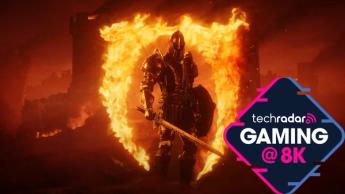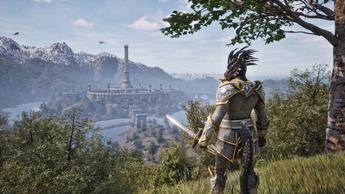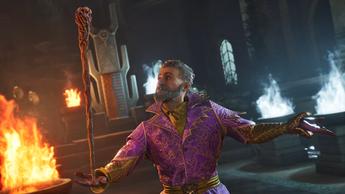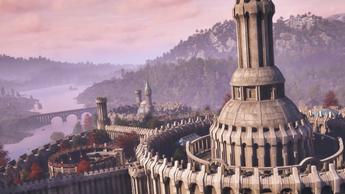Oblivion Remastered in 8K mit NVIDIA RTX 5090 erkundet die Vergangenheit und Zukunft des Gamings, und zeigt sowohl Stärken als auch Schwächen
Wie beeinflusst die 8K-Remastering von Oblivion mit NVIDIA RTX 5090 das Gameplay und die Optik?

Bethesdas The Elder Scrolls IV: Oblivion ist ein klassisches Rollenspiel, das viele Gamer verpasst haben. Es wurde 2006 für PC und Xbox 360 veröffentlicht und war ein Spiel, das ich immer ausprobieren wollte, aber damals einfach nicht dazu gekommen bin. Damals war ich frisch von der Uni, lebte mit knapper Kasse und hatte nur meine treue PlayStation 2 zur Unterhaltung.
Als dann die Fortsetzung, Skyrim, erschien, hatte ich auf einen Gaming-PC aufgerüstet, der moderne Titel ausführen konnte, und wurde schnell zum Fan. Ich verbrachte unzählige Stunden damit, die weite Welt von Skyrim zu erkunden, doch ich hatte immer das Gefühl, einen wichtigen Teil der Geschichte zu verpassen—Oblivion. Seine Memes und sein Ruf machten mich neugierig, und ich hatte das Gefühl, etwas in der Gaming-Geschichte zu verpassen.
Kürzlich überraschte Bethesda die Fans, indem sie The Elder Scrolls IV: Oblivion Remastered ankündigten und veröffentlichten, mit verbesserten Grafiken und Qualitätsverbesserungen. Ich war gespannt, dieses beliebte Spiel endlich zu erleben.
Dank überarbeiteter Visuals, die von Unreal Engine 5 angetrieben werden, und fortschrittlicher Raytracing-Beleuchtung wollte ich sehen, wie gut dieses Remaster auf der neuesten High-End-Gaming-Hardware läuft, inklusive der leistungsstarken Nvidia RTX 5090-Grafikkarte in 8K-Auflösung. Es ist spannend, ein Spiel wiederzuentdecken, das so viele Abenteuer in der Gaming-Geschichte geprägt hat—jetzt mit atemberaubender Grafik und modernen Verbesserungen.

Can it even run at 8K?
After first loading Elder Scrolls IV: Oblivion Remastered, I headed to the graphical options and was a bit concerned, as it looked like the maximum resolution I could pick was 4K (3840 x 2160), despite the screen I was using having a native resolution of 7680 x 4320.
However, I soon discovered that if I set the game to Borderless mode, the game runs at the resolution you've set in Windows. It's a bit confusing, as the resolution box is grayed out when using Borderless mode, yet says 3840 x 2160; this initially led me to believe the resolution was locked at 4K, but I confirmed it was indeed running at 8K.
With all the graphical settings set to 'Ultra', but with upscaling tech such as DLSS turned off, I ran about the open world fields, getting into a few fights with flying monsters.
Or at least, I tried to, as running Elder Scrolls IV: Oblivion Remasteredat native 8K with no upscaling help made even the mighty RTX 5090 struggle, with an average frame rate of 21fps (frames per second).
This led to the game feeling sluggish and jittery – and it was particularly painful trying to attack Imps, which hover above ground and throw spells at you.
However, I do have to give the RTX 5090 credit for even managing 21fps. While the Elder Scrolls IV: Oblivion Remasteredis based on an almost 20-year-old game, visually it looks very good, so even getting a remotely playable experience at full 7680 x 4320 resolution shows the kind of raw performance the RTX 5090 is capable of.
That said, it's becoming increasingly obvious that PC gamers are using upscaling tools like DLSS (Deep Learning Super Sampling) to improve performance, even with flagship GPUs like the RTX 5090.
In previous articles I've found that these tools can make a huge impact to making games playable at 8K without having to sacrifice too much image quality, and that was again the case here.
Keeping the graphics setting at Ultra, I turned on DLSS and set it to 'Balanced', which (as the name suggests) strikes a balance between increasing performance and maintaining graphical fidelity.
The way these upscaling tools work is by rendering the game at a lower resolution and then using artificial intelligence to add pixels to increase the resolution. The lower the starting resolution, the better the performance will be, but because the AI will need to generate more pixels to upscale the game to the required resolution, more errors and artefacts can be introduced, impacting graphics quality.
The impact to performance was immediate, with the RTX 5090 now running Elder Scrolls IV: Oblivion Remasteredat 47fps. Instantly, the game felt much smoother and more fun to play.
I did notice a few small visual artefacts – however, the most noticeable was a giant reflection of my weapon when looking at water. This is a result of screen space reflections and is a pretty common complaint with Oblivion – and thankfully, it's easy to 'fix' by turning off screen space reflections in the graphics settings of the game.

Making sacrifices
Kommt es im Gaming auf Opferbereitschaft an, kann das das Erlebnis deutlich verbessern. Zum Beispiel ist es eine Herausforderung, die Bildrate bei hohen Auflösungen wie 8K zu erhöhen. Während eine Steigerung der Performance von 21 fps auf etwa 47 fps schon eine große Verbesserung darstellt, streben viele Gamer immer noch mindestens 60 fps für ein flüssiges Spielerlebnis an. Der Wechsel in den Performance-Modus bei Upscaling-Technologien legt den Fokus auf Geschwindigkeit statt auf Bildqualität, was ein flüssigeres Gameplay ermöglicht – ähnlich wie bei einem klassischen Spiel, das fast 60 fps läuft – allerdings können dabei visuelle Artefakte wie Geisterbilder um bewegte Objekte entstehen. Manchmal ist es am besten, Qualität und Leistung auszubalancieren, auch wenn das einen leichten Rückgang der Bildrate bedeutet. Glücklicherweise gibt es verschiedene Tricks und Einstellungsmöglichkeiten, die es ermöglichen, beeindruckende Grafiken und hohe Bildraten bei 8K-Auflösung zu erzielen, ohne zu viel aufzugeben – so wird das Spielerlebnis sowohl schön als auch reaktionsschnell.
Frame gen – why the hate?
By using an Nvidia-capable GPU with DLSS, I could also enable the Frame Generation feature in Oblivion's settings.
This feature again uses AI – this time to generate an image and insert it between two frames rendered by the GPU. If implemented well, this can give a boost to the framerate, as more frames are being shown per second, without any noticeable drops in quality.
I say 'if implemented well', because when the feature first started appearing in games a few years ago, the generated frames were sometimes all-too obvious, leading to a blurring effect that put me off from using the tool for a few years.
Since then, Nvidia has worked with game developers to improve Frame Generation, and I've found recent implementations to work a lot better. It's still a controversial feature among some PC gamers, however, who argue that these are not 'real' frames, and by relying on Frame Generation game developers are not bothering to optimize their games for PC.
I'm more of the opinion that if a feature works well, makes playing games more enjoyable and there's no noticeable downside, then I don't care that much if a frame is real or not.
Having said that, when the results are disappointing, I'm not going to be a fan – and I do share concerns that a reliance on tech such as DLSS and Frame Generation to smooth over poor performance and optimization would be a worrying trend.
With Frame Generation on, DLSS on Balanced and graphics preset to Ultra, I was able to get Oblivion running at 82fps at 8K. This big leap again improved the overall feel of the game, and running through fields and fighting Imps was a joy.
Those small graphical imperfections kept on nagging at me, however. When a game is blown up to 8K on a large (for a monitor) 55-inch screen, any imperfection also gets magnified.
So, with the fps overhead that Frame Generation gave me, I set DLSS to Quality, minimising the amount of upscaling needed to reach 8K and hopefully removing those graphical issues.
The result was indeed a cleaner picture, but with a drop in frame rate to 70fps. Still impressive and well above the 60fps I aim for (and with almost all 8K TVs maxing out at 8K at 60Hz, any benefit of going over 60fps is limited).
Finally, I decided to try out Oblivion with Nvidia's latest feature, which is exclusive to RTX 5000 series GPUs such as the RTX 5090: Multi Frame Generation (MFG).
This is the next evolution of Frame Generation, with the GPU using AI to generate up to three extra frames for every 'real' rendered frame. I've been very impressed with this feature in previous tests, and wanted to see how well it worked with Oblivion.
There's no built-in support for MFG in Elder Scrolls IV: Oblivion Remasteredat the moment, but you can enable it via the Nvidia app for Windows 11.
With MFG enabled, I loaded Elder Scrolls IV: Oblivion Remastered and was treated to frame rates of 117fps on average. Seriously impressive stuff, especially as although the RTX 5090 was now generating three times as many frames, there was no noticeable impact to graphic fidelity compared to when I was playing with standard Frame Generation enabled.

Fazit: Zurück zu 4K-Gaming
Ich habe erneut festgestellt, dass das Spiel Elder Scrolls IV: Oblivion Remastered mit der Nvidia RTX 5090 bei 8K-Auflösung spielbar ist, dank Funktionen wie DLSS und Multi-Frame Generation. Allerdings waren die visuellen Artefakte, die durch diese Technologien verursacht wurden, aufgrund der Neuheit des Spiels oder der zugrunde liegenden Technologie recht deutlich sichtbar und störend.
Indem man wieder auf native 4K-Auflösung umschaltet und weniger auf diese Upscaling-Technologien setzt, liefert die RTX 5090 eine flüssige Performance und eliminiert die Artefakte, was zu einem klareren und gleichmäßigeren visuellen Erlebnis führt.
Dies zeigt, dass 4K weiterhin die optimale Auflösung für Spiele ist. Trotz Bedenken sind Upscaling-Technologien von Herstellern wie Intel noch keine perfekten Lösungen, die die Leistung verbessern, ohne visuelle Abstriche zu machen. Sie sind vielversprechende Werkzeuge, befinden sich aber noch in der Entwicklung.
